What are parts of speech? In the American English language, parts-of-speech is a category to which a word is assigned in accordance with its syntactic functions. They exist under the verb, noun, pronoun, interjection, adjective, conjunction, adverb, and preposition forms.
Learn more about parts of the speech in this comprehensive worksheet…
What are parts of speech?
“Parts of speech” refers to the essential words used in sentence formation in the English language.
Every word used in a sentence structure plays an important role in defining the sentence’s meaning. These words use and placement give proper intentions in sentence structures.
Parts of speech are the basic grammar lessons taught during the primary phases of learning English.
Any word used in sentence formation falls into one of these categories for proper sentence structure.
Some of those words can be a part of one or more parts of speech. This topic further explores the essential parts of speech used in the English language.
Watch this as a video lesson
In total, there are nine categories of parts of speech
These nine parts of speech are namely: Verbs, Nouns, Adjectives, Determiners, Adverbs, Pronouns, Prepositions, Conjunctions, and Interjections.
Another additional classification is used as a part of speech, i.e., Articles, a subprogram of determiners.
To comprehend the meaning and use of each word in the English language, it is essential to clearly understand the various parts of speech and select the right parts of speech form at the appropriate place in the sentence.
What are the 9 parts of speech with their functions?
Here are the nine parts of speech and how they impact the English language.
| Part of Speech | Definition | Words |
| Noun | Used to name a place, person, thing, or idea. | California, man, park |
| Pronoun | Used to replace the name of a person, place, thing or idea. | He, she, it, they |
| Verb | A verb expresses what the subject does. | Leave, do, work put, eat |
| Adverb | Used to describe verb, adverb, or adjective. | Always, silently, quickly |
| Adjective | Words that are used to describe qualities or things. | Long, short, tiny, bright, dark |
| Preposition | Shows the relationship between other words in a sentence. | In, on, at, with, by |
| Interjection | Words that express emotions or feelings. | Wow, oh, ah, yikes |
| Conjunction | Words that join words or groups of words together. | And, but, because, where, also |
Verb
‘Verbs’ are the words used in a sentence to define the action/state of action being performed. Most of the sentences in sentence formation require the inclusion of verbs.
Some examples of verbs used in the English language are Love, Break, Fall, and Cry. These are the basic forms of verbs and are known as infinitives.
Most of the verbs used have two other major forms called participles. The use of these participles is for the formation of various verb-tense combinations.
These participles define the forms of verbs concerning the time of action/performance. These verb-tense combinations can be used in two types: Active voice and passive voice.
Noun
A ‘noun’ are words used in a sentence to give recognition or the name of an object, individual, or animal.
Nouns can be sub-classified into two major categories: Common nouns, which give generic descriptor names to things, and common items, such as a bat, a bicycle, etc. The other category of nouns is Proper nouns, which have specific descriptor names to refer to a specialized object, place, or individual, such as Charley, The Empire State Building, The Telegraph, etc.
Additionally, nouns can be classified as singular nouns and plural nouns based on the number of individuals/objects.
Singular Nouns
The definition of a Singular Noun is the same as that of a noun when used commonly. It carries the same definition as the noun: “A word referring towards an individual/object/event/material/place.”
Plural Nouns
The word plural relates to “more than one in certain languages or more than two in certain languages.”
Thus singular nouns can be converted to their plural noun format when there is an implication of more than one or two objects/individuals/places.
A general Singular/Common Noun can be turned into the appropriate form of a Plural Noun by adding a ‘s’/’es’/’ ies’/’ves.’ It is also initiated by changing ‘us’ to ‘i’, ‘is’ to ‘es’, or ‘on’ to ‘a’.
Some common nouns do not change when interchanged between their singular and plural noun forms. Some other common nouns do not fall under plural nouns and are called irregular nouns, which are made plural by changing the spelling or adding a suffix to the word.
Adjective
‘Adjectives’ are words that give a description or modify the scope of nouns/pronouns by being specific. For example, adjectives used to define a noun can be red, small, hot, common, etc.
An adjective is usually placed before a noun or after the verb that it modifies. Three forms of adjectives are used to compare similar characteristics of different individuals/objects. These three degrees of comparison are:
- Positive/Absolute form
This comparison of adjectives defines the original form of the adjective as stated in English. For example, “this candy is tasty.” This degree of comparison states that no relative subject is available for comparison.
- Comparative form
This form of the adjective gives a relative comparison between two objects performing similar actions with identical characteristics. For example, “the candy we had today is tastier than the one we received yesterday.”
This form of the adjective gives the superiority declaration of one object over similar objects possessing similar characteristics. For example, “this candy is the tastiest I have ever had in the last two years.”
Adjectives can be sub-classified based on their function in sentence formation. This sub-classification is:
These adjectives show/represent the possessiveness of an object. For example, mine, my, his/her, their, its, etc.
These adjectives modify the noun/pronoun by interrogation. Only a select few adjectives are available in this form. For example, whose, which, what, and where.
These adjectives describe the current state/position of the noun/pronoun concerning space/time. For example, this, these, those, that.
These adjectives are a result of the combination of two or more adjectives. The resulting adjective modifies the subject in the sentence. For example, hand-dried, heavy-weighted, spike-haired, etc.
Determiner
‘Determiners’ are the words placed before a noun/pronoun group terms to refer to a single/multiple things. Some commonly used determiners in English are ‘a’, ‘the’, ‘some’, ‘any’, and ‘this.’ Determiners are generally placed before descriptive adjectives. It tells the reader more about the description of the noun being referred to.
Determiners are classified into sub-categories, articles, and demonstratives.
Article
An ‘Article’ can be either definite or indefinite. An article modifies a noun/pronoun without specifying any description of the object. In English, an example of a ‘definite article’ is the, whereas examples of two ‘indefinite articles’ are a and an.
Here, the refers to specific things or things that are identified beforehand. A or a refer to non-specific things that have not been identified beforehand.
Demonstratives
A ‘Demonstrative’ is defined as a demonstrative adjective/pronoun based on its usage in the sentence. Some examples of demonstratives are ‘this’, ‘that’, and ‘those’.
A determiner has the same rules of use as in the case of adjectives in sentence formation. Thus, confusion takes place when carefully choosing the type of parts of speech to assign when given a choice of either a determiner or adjective.
Adverb
An ‘Adverb’ defines essential information about the verb, similar to what an adjective is to a noun. It provides a descriptor for a verb used in a sentence and some cases, can also describe an adjective or another adverb.
Some adverbs used in sentences with verbs are ‘slowly’, ‘hastily’, ‘unfortunately’, and ‘angrily’.
Adverbs are further sub-classified into various types based on their application in a sentence.
They are:
- Adverbs of Time (to inform about the occurrence of a verb), For example, ‘now’, ‘tomorrow’, and ‘soon’.
- Adverbs of Manner (to describe the action of a verb), For example, ‘hastily’, ‘slowly’, and ‘minutely’.
- Adverbs of Place (to indicate the place of action of the verb),
- Adverbs of Frequency (to describe the frequency of a verb action),
- Adverbs of Degree (to describe the intensity of an action),
- Conjunctive Adverbs (are used to link/act as a conjunction to two sentences).
Pronoun
A ‘Pronoun’ is a word used in specifically providing an alternate name for a non/noun phrase. They are alternate words for referring to an object/individual when the requirement of a noun is unnecessary, as the noun has been mentioned previously in some parts of the sentence.
Some examples of pronouns are ‘it’, ‘he/she’, and ‘himself/herself’.
Pronouns are sub-classified into different categories based on their use in the sentence.
Some of these sub-categories are:
- Relative Pronouns (to relate a part of a sentence with the other)
- Possessive Pronouns (to show possessiveness)
- Reflexive Pronouns (to refer back to the subject of discussion)
- Demonstrative Pronouns (to refer to specific objects/individuals)
- Interrogative Pronouns (to ask questions)
- Indefinite Pronouns (to avoid reference to any specific object/individual/place)
- Personal Pronouns (to use as substitutes for proper names)
- Subject Pronouns (to assign acting on an object)
- Object Pronouns (to assign receiving action towards an object)
- Reciprocal Pronouns (to express two-way/mutual relationship)
Preposition
A ‘Preposition’ is a word used as a connective between a noun, a noun phrase, or a pronoun with another word.
Prepositions are used in sentence formations to convey these meanings:
- To show the direction towards/of something/someone
- To refer to the period of an action taking place
- To specify the location/position of an object
- To present the space and time relationship between objects
Based on their use and function, prepositions are classified into four subtypes:
- Prepositions of Time (to indicate the happening of an action/event)
- Preposition of Place (to indicate the location of an object)
- Preposition of Direction (to indicate the direction/orientation of an object)
- Prepositions of Spatial Relationship (to indicate an object moving away/towards a source)
Conjunction
A ‘Conjunction’ is a word that combines two/more objects and behaves as connectives in a sentence. These can appear in the beginning/middle/end of the sentence following the location of the objects.
There are three types of conjunctions used in sentence formation:
- Coordinate conjunction (to combine two independent clauses)
- Subordinate conjunction (to combine an independent with a dependent clause)
- Correlation conjunction (to combine two phrases having equal weightage)
Interjection
An ‘Interjection’ is a word to convey the expression of a variety of emotions/feelings. As such, there is no specific rule for the use of interjection and where it is to be placed.
However, in most cases, it is placed at the beginning of the sentence. For example, some of the most commonly used interjections are ‘ouch’, ‘phew’, and ‘well’.
| Form | Example |
| Noun | The dog howled. |
| Pronoun | It woke the baby. |
| Verb | The loving mother comforted the child. |
| Adjective | The caring father rocked the baby. |
| Adverb | The dog howled loudly. |
| Preposition | The baby cried for a long time. |
| Conjunction | The baby gazed at his mother and father. |
| Interjection | Phew, the baby fell back asleep. |
Parts of speech examples
Here are some examples of the parts of speech used in sentences. Note the placement and its relation with other parts of speech present in the sentence format.
Verb
- John is cutting a pipe.
- John intends to come to the office this Monday.
- Jogging regularly is good for health.
- Drinking and driving put other motorists in danger.
- Would you want to wear a suit?
- I love to sing in between classes.
See another example in the image below.
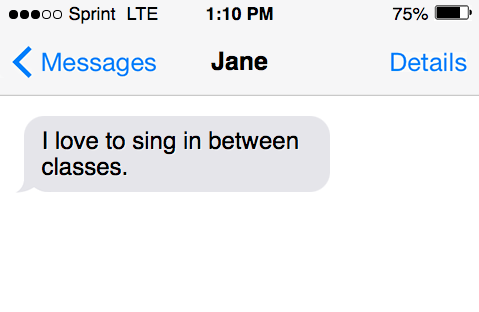
Noun
- Juno ran towards the classroom.
- The janitor requested the students to clear their lockers.
- The monkey was caged after being sedated.
- I gifted my brother a phone.
- Why did you purchase the book?
- I misplaced the manuscript.
- Do you want to eat some ice cream?
- Mum loved my new car.
- Daniel gifted his brother a Porsche.
See another example in the image below.

Adjective
- I purchased a blue suit for the reception.
- Mary purchased two oranges from the fruit seller.
- The curry is tasty.
- Juno’s brother is arrogant.
- The documentary that premiered on television was fascinating.
- Giovanni Giorgio is a great music composer.
See another example in the image below.
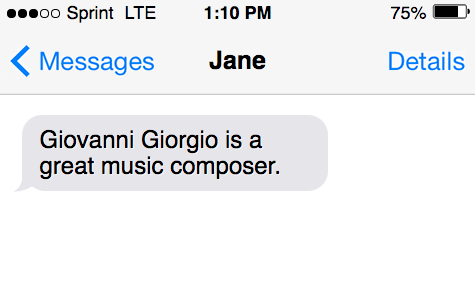
Determiner
- My house is currently under lease.
- This novel is lengthy.
- I purchased some fruits and vegetables.
- She sent me an expensive watch.
- Velma loved the dress gifted by her parents.
- Joyce and Jill watched a movie together.
- Grandma gave us materials to prepare the dessert.
See another example in the image below.
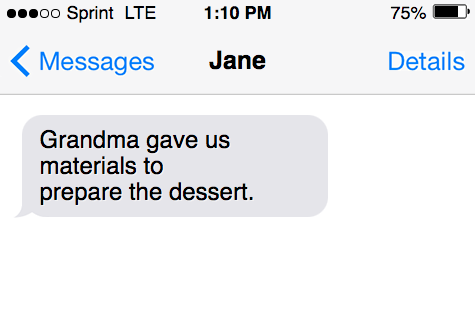
Adverb
- Typically, we visit Mom on Mondays.
- Don’t you taste the coffee to be too bitter?
- Do not be nervous. You will eventually get the hang of it.
- The movie I watched was very scientific.
- It is scorching hot inside the workshop.
- Can I visit the office today?
See another example in the image below.

Pronoun
- His aunt will be staying at the apartment for a while.
- He is the man I was referring to.
- I found my missing luggage outside the airport.
See another example in the image below.

Preposition
- I won’t be coming to the office in the afternoon.
- He arranged the cutlery on the table.
- Bhaskar made the dog hide under its bed.
- I enjoy strolling by the lake in the mornings.
See another example in the image below.
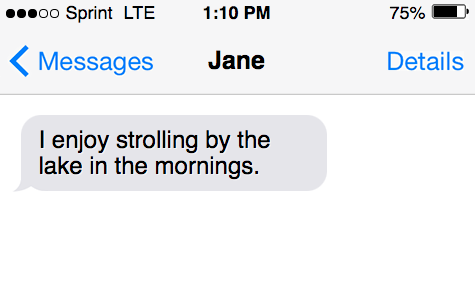
Conjunction
- James and I trekked to the hilltop today.
- I stayed back home because I felt uneasy.
- He did not enjoy the yogurt, yet he finished it.
See another example in the image below.
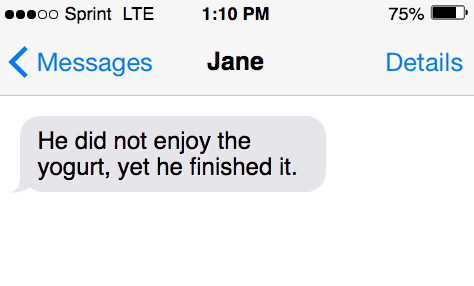
Interjection
- Hurray! We got the funding.
- Ouch! That wound looks severe.
- Wow! You look great in the wedding gown.
- Oh my God! I hope he is safe.
See an example in the image below.
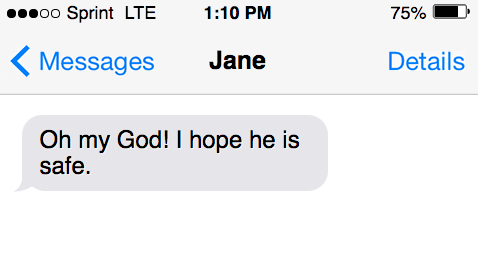
Words with more than one job
Many parts of speech can have more than one function/job in the sentence. This improves the versatility of the words being used and makes the use more situational in its placement and conveyance of meaning.
Examples
For
- Myers can shift for herself (Preposition)
- Give prayers to the Almighty; for He is the one above all (Conjunction)
More
- We require more women to have the same vigor. (Adjective)
- More of the women died in the operating room than in the cabin. (Pronoun)
- Agatha needs to shut the gossiping and work more (Adverb)
To see how all the objects work together, see the table below.
| pron. | verb | adj. | noun | conjunction | pron. | verb | pron. |
| She | likes | big | monkeys | but | I | hate | them |
Here is a chart showing the parts of speech:
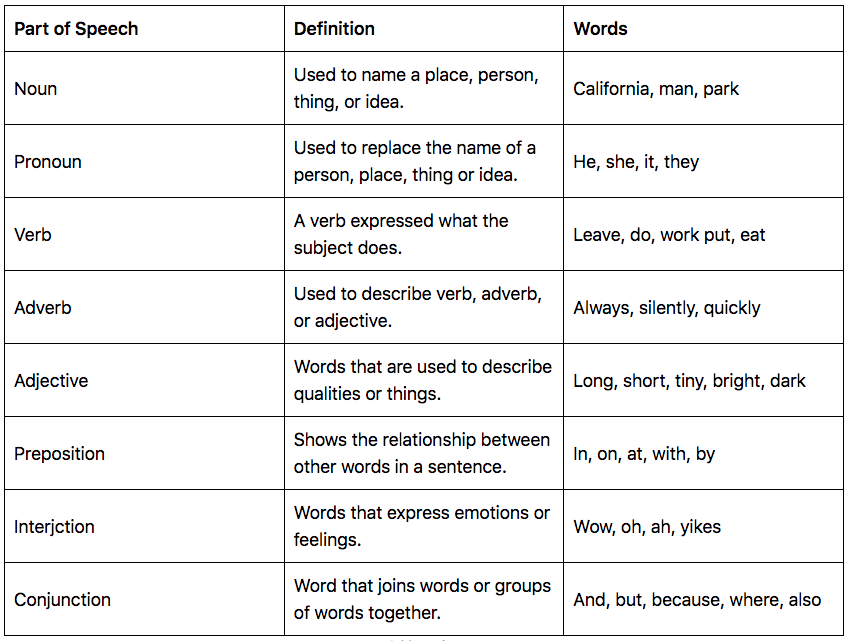
How to identify parts of speech
In sentence formation, it often becomes difficult to ascertain the parts of speech represented by each word. To help out and to make the process of identification easier, follow these steps:
- Identify any word which names an object/individual/place in a generalized form as a noun.
- To identify a specific noun, use pronouns.
- Any words which describe/identify actions/performance are verbs.
- Any word that modifies or gives a greater definition to nouns is an adjective.
- Any word that modifies or gives meaning to the actions of verbs, are adverbs.
- It is easy to pick out prepositions as they describe relationships between a noun/pronoun with other nouns/pronouns.
- Any joiner used to join two clauses is a conjunction.
- Exclamations generally follow any interjections in the text.
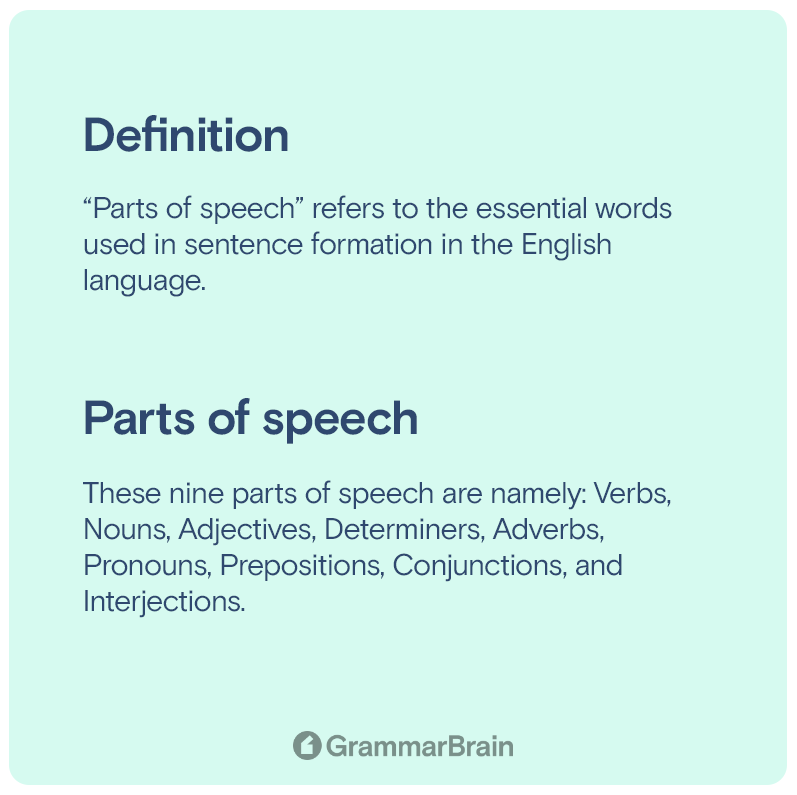
Parts of speech
More parts of speech:
- Parts of speech
- Adjectives
- Conjunctions
- Verbs
- Prepositions
- Possessive nouns
- Irregular plural nouns
- Proper nouns
- Concrete nouns
- Collective nouns
- Possessive and plural nouns
Sources:
- Verbs: The Definitive Guide
- Nouns | Explore Definition, Examples & Types with Examples
- What Are Pronouns? Definitions and Examples
- What Are Adverbs? (with Examples)
- Interjections – Explore Meaning, Definition, Usage and Examples
- What Is A Conjunction? Types & Examples
- The 9 Parts of Speech: Definitions and Examples
- What Is a Determiner?
- The 8 Parts of Speech: Examples and Rules
- Adverbs – What is It? Explore the Meaning, Definition, Types, Usage and Examples
Inside this article
Fact checked:
Content is rigorously reviewed by a team of qualified and experienced fact checkers. Fact checkers review articles for factual accuracy, relevance, and timeliness. Learn more.
Core lessons
Glossary
- Abstract Noun
- Accusative Case
- Anecdote
- Antonym
- Active Sentence
- Adverb
- Adjective
- Allegory
- Alliteration
- Adjective Clause
- Adjective Phrase
- Ampersand
- Anastrophe
- Adverbial Clause
- Appositive Phrase
- Clause
- Compound Adjective
- Complex Sentence
- Compound Words
- Compound Predicate
- Common Noun
- Comparative Adjective
- Comparative and Superlative
- Compound Noun
- Compound Subject
- Compound Sentence
- Copular Verb
- Collective Noun
- Colloquialism
- Conciseness
- Consonance
- Conditional
- Concrete Noun
- Conjunction
- Conjugation
- Conditional Sentence
- Comma Splice
- Correlative Conjunction
- Coordinating Conjunction
- Coordinate Adjective
- Cumulative Adjective
- Dative Case
- Determiner
- Declarative Sentence
- Declarative Statement
- Direct Object Pronoun
- Direct Object
- Diction
- Diphthong
- Dangling Modifier
- Demonstrative Pronoun
- Demonstrative Adjective
- Direct Characterization
- Definite Article
- Doublespeak
- False Dilemma Fallacy
- Future Perfect Progressive
- Future Simple
- Future Perfect Continuous
- Future Perfect
- First Conditional
- Irregular Adjective
- Irregular Verb
- Imperative Sentence
- Indefinite Article
- Intransitive Verb
- Introductory Phrase
- Indefinite Pronoun
- Indirect Characterization
- Interrogative Sentence
- Intensive Pronoun
- Inanimate Object
- Indefinite Tense
- Infinitive Phrase
- Interjection
- Intensifier
- Infinitive
- Indicative Mood
- Participle
- Parallelism
- Prepositional Phrase
- Past Simple Tense
- Past Continuous Tense
- Past Perfect Tense
- Past Progressive Tense
- Present Simple Tense
- Present Perfect Tense
- Personal Pronoun
- Personification
- Persuasive Writing
- Parallel Structure
- Phrasal Verb
- Predicate Adjective
- Predicate Nominative
- Phonetic Language
- Plural Noun
- Punctuation
- Punctuation Marks
- Preposition
- Preposition of Place
- Parts of Speech
- Possessive Adjective
- Possessive Determiner
- Possessive Case
- Possessive Noun
- Proper Adjective
- Proper Noun
- Present Participle
- Prefix
- Predicate



